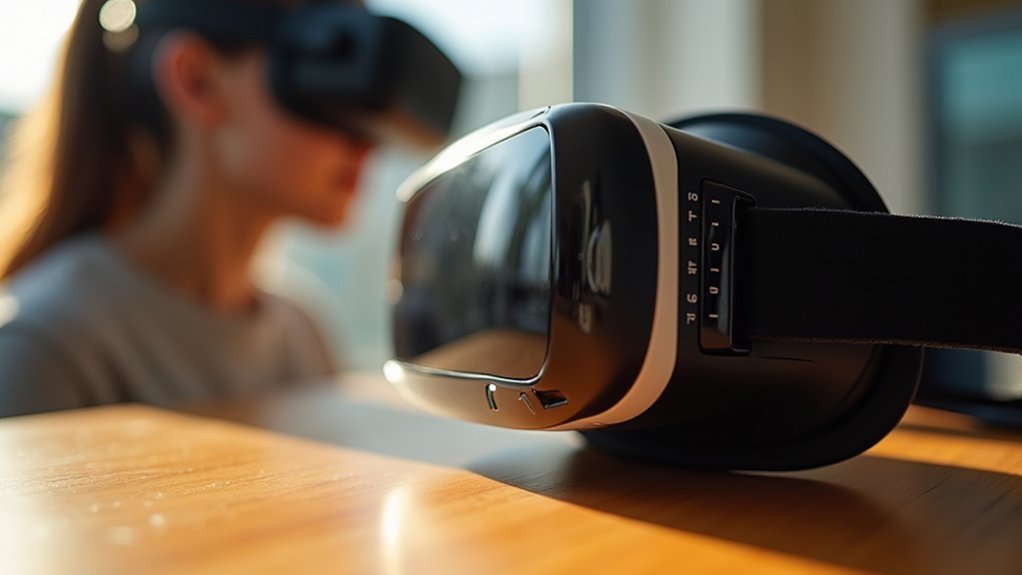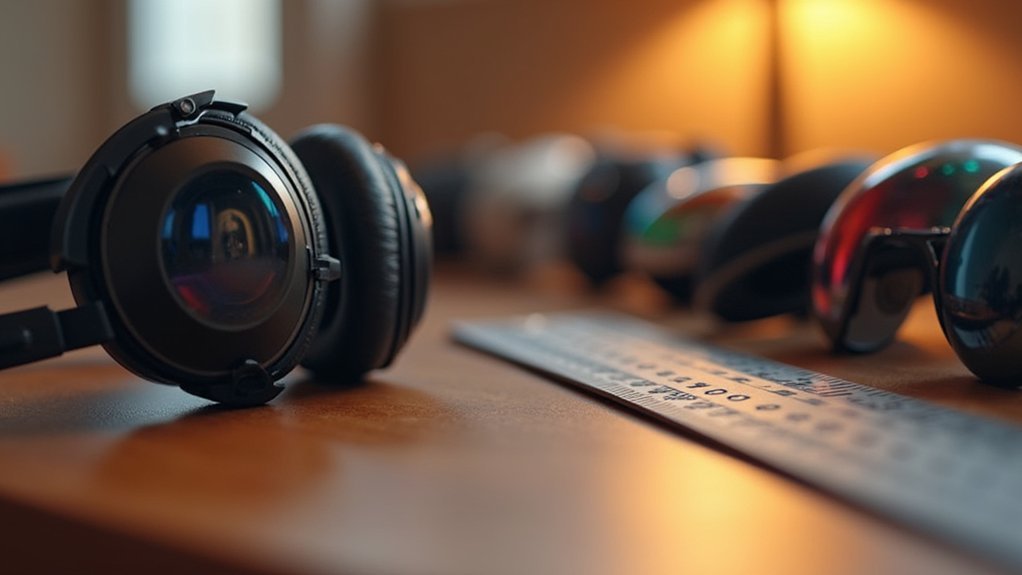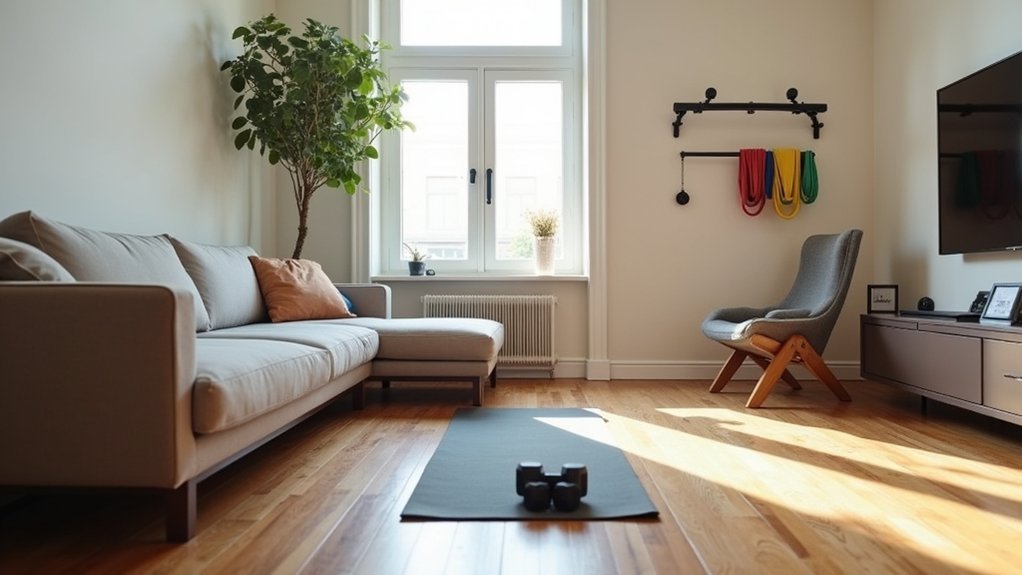Adjustable IPD (interpupillary distance) matters because it aligns the headset’s optical centers with your eyes for ideal comfort and visual clarity. Without proper alignment, you’ll experience eye strain, headaches, blurry vision, and distorted depth perception—especially if your IPD differs from the average 61-64mm range. Women, children, and users with narrower or wider faces benefit most from adjustable settings. The right IPD setting can greatly reduce cybersickness and enhance your overall VR experience.
The Science Behind IPD and Visual Comfort

When you put on a virtual reality headset, the distance between your pupils—known as interpupillary distance (IPD)—becomes critically important for your visual experience.
Your IPD is a key physiological measurement that varies between individuals, with the average adult measurement around 61mm, and men typically having IPDs about 3mm wider than women.
Proper alignment between your eyes and the headset’s optical centers is essential.
When the lenses don’t match your unique IPD, your brain struggles to merge the two images properly, causing eye strain, visual fatigue, and even headaches.
This misalignment creates prismatic effects and distortions that reduce your comfortable viewing time in VR environments.
Recent research with 65 optometry students showed that a 5 mm misalignment reduced comfortable viewing time to just 2.3 minutes compared to 4.9 minutes with proper alignment.
For prolonged, comfortable sessions, the optical centers must correspond with your pupil centers, especially when focusing on virtual objects at varying distances.
How IPD Mismatch Affects Your VR Experience
Your incorrectly matched IPD setting can greatly distort your visual field, creating blurriness, double vision, or image ghosting that dramatically reduces immersion.
This mismatch forces your eyes into unnatural divergent fixation, triggering headaches, eye strain, and nausea that worsen the longer you use your headset. Proper alignment with the sweet spot of VR lenses is essential for maintaining visual clarity and preventing physical discomfort during extended sessions.
The discomfort you’ll experience directly correlates with how far your actual IPD differs from the headset’s setting, with even small discrepancies potentially ruining your VR session.
Vision Distortion Issues
Although VR headsets aim to deliver immersive experiences, incorrect interpupillary distance (IPD) settings can greatly compromise visual comfort and perception.
When your headset’s IPD doesn’t match your actual eye distance, you’ll likely experience divergent parallax—your eyes uncomfortably diverging outward, especially if the IPD is set too wide.
You might notice double vision as images fail to align properly between your eyes. Your depth perception becomes biased, causing you to misjudge distances in virtual environments. IPD adjustments can dramatically alter your perception of size, making virtual worlds appear larger or smaller depending on whether the setting is narrower or wider than your actual measurement.
The rendering quality suffers too, as the 3D effect becomes less convincing with mismatched IPD.
The visual discomfort isn’t just annoying—it can lead to eye strain during longer VR sessions.
These issues are particularly problematic for users with smaller IPDs, including children, who often fall outside standard headset ranges.
Physical Discomfort Triggers
Physical discomfort from IPD mismatches extends far beyond mere visual issues, affecting your entire VR experience.
When your headset’s lenses don’t align with your eyes, you’ll likely experience increased eye strain and fusional difficulty as your visual system struggles to merge the two images.
This mismatch creates binocular stress, leading to headaches, nausea, and visual fatigue characterized by eye pain and blurred vision. Adult IPDs typically range from 45 to 80 mm, yet most headsets fail to accommodate this full spectrum.
You might notice these symptoms intensifying during longer VR sessions, often forcing you to cut your experience short.
If you’re female or have a history of motion sickness, you’re particularly susceptible to cybersickness from IPD non-fit.
These physical reactions aren’t just momentary inconveniences—they can greatly impact your satisfaction with VR and potentially discourage continued use.
Gender and Age Considerations for IPD Adjustment

Your IPD likely differs from others based on gender, with women typically having narrower measurements than men, which explains why female users report higher rates of cybersickness with fixed-IPD headsets.
Children and elderly users also need special consideration, as younger users have smaller IPDs while older adults may need comfortable adjustments to prevent eye strain.
When choosing a VR headset, you’ll want one with adjustable IPD settings that can accommodate these demographic variations for the most comfortable and immersive experience. Studies show women experience 40% higher intensity of cybersickness symptoms compared to men when using virtual reality technology.
Gender IPD Variations
Notable differences in interpupillary distance exist between men and women, with males typically having wider IPD measurements than females. Research across various populations consistently shows this gender disparity, with studies on Arab populations revealing males have IPD measurements approximately 2.0 mm wider than females.
Similar patterns appear in Caucasian populations. Studies show that males experience approximately 3% increase in FIPD from mid-teens to later middle age.
When you’re selecting a headset, these gender differences matter greatly. Women typically need headsets that accommodate narrower IPD settings, while men often require wider adjustments.
Without proper accommodation for these variations, you’ll likely experience discomfort, eye strain, or reduced visual quality. Manufacturers who incorporate adjustable IPD features create more inclusive products that serve diverse users better, though this may increase production costs.
The growing market demand reflects users’ needs for personalized comfort regardless of gender.
Age-Related IPD Changes
While gender differences in IPD represent one important factor in headset design, age-related changes also play a significant role in determining the ideal IPD adjustment range. Your IPD doesn’t remain static throughout life—it evolves as you age, with distinct patterns in different life stages. Research involving 416 participants aged 18 to 73 years revealed that IPD measurements demonstrate high reliability across different age groups.
| Age Group | IPD Change | Considerations | Impact on Headset Fit |
|---|---|---|---|
| Children (<18) | Rapid growth | Still developing | Needs highly adjustable IPD |
| Adults (18-50) | Stabilization | Typical range: 60-65mm | Standard IPD range works well |
| Middle-aged (50-65) | Slight increase | ~1mm wider than younger adults | May need wider settings |
| Elderly (65+) | Continued widening | Facial structure changes | Benefits from extended upper range |
Understanding these age-related changes helps explain why adjustable IPD settings are essential for comfortable viewing across your lifespan.
Comparing Fixed vs. Adjustable IPD Solutions
The debate between fixed and adjustable IPD mechanisms represents one of the most essential design decisions in VR headset development.
When you’re choosing between these options, the implications for comfort and visual quality are considerable.
Fixed IPD headsets target average measurements (typically 63-64mm) but can reduce picture quality by 15-55% if your IPD differs considerably.
Fixed-IPD headsets optimize for average users while significantly degrading visual quality for those with non-standard measurements.
You’ll likely experience blurry images, doubled vision, and increased eye strain during extended sessions.
Conversely, adjustable IPD systems optimize lens alignment with your eyes, maximizing clarity and reducing fatigue.
Physical sliders offer real-time visual feedback and precise customization compared to stepped or software-based alternatives.
For multi-user environments or if your IPD falls outside average ranges, adjustable IPD isn’t just a premium feature—it’s essential for maintaining immersion and comfort.
Quest 3 has emerged as a notable option with its wide IPD range, accommodating more users without sacrificing visual quality.
Current Market Options With Best IPD Ranges

Now that we’ve examined the advantages of adjustable IPD systems, let’s look at top headsets offering the most versatile IPD ranges.
The Pimax Crystal Series leads with an impressive 58-72mm range plus eye-tracking for auto-fine-tuning.
HTC VIVE Pro 2 delivers professional-grade adjustability (60-72mm) with ergonomic design ideal for extended sessions.
Meanwhile, Sony’s PlayStation VR2 offers approximately 55-70mm, accommodating users with narrower facial structures.
Both Valve Index and Meta Quest 3 provide mechanical IPD adjustment ranging from 58 – 70mm, striking a balance between comfort and visual clarity.
When selecting your ideal headset, prioritize these IPD factors:
- Match your personal IPD measurement with the headset’s adjustment range
- Consider manual adjustment mechanisms for precision over preset positions
- Look for complementary features like eye-tracking that enhance IPD optimization
The right IPD adjustability guarantees visual clarity, reduces discomfort, and maximizes your VR immersion.
Impact of IPD Adjustment on Long-Term VR Use
Proper IPD adjustment greatly impacts your long-term virtual reality experience beyond mere comfort during single sessions. Each millimeter of IPD mismatch increases oculomotor cybersickness symptoms and disorientation, potentially causing cumulative eye strain over time.
Without accurate IPD settings, you’ll likely experience rapidly developing discomfort, limiting your effective VR usage time. Eye care professionals emphasize IPD matching as essential for preventing maladaptive changes in eye muscles and brain processing. Sustained improper focus demands due to misalignment risk developing chronic visual fatigue or worsening existing conditions. Users with IPDs below 61mm should prioritize headsets with IPD adjusters immediately to prevent these negative effects.
Conversely, precise adjustment supports correct binocular vision, reducing strain and allowing longer, uninterrupted sessions. You’ll find extended VR exposure more comfortable, enhancing immersion and productivity—particularly beneficial for training applications and professional use requiring sustained engagement.
Technical Implementation of IPD Systems
While consumer VR continues to evolve, technical implementations of IPD systems have grown increasingly sophisticated to accommodate diverse human physiological requirements.
Today’s headsets employ either mechanical adjustments that physically move lenses and displays, or advanced automatic systems that integrate eye tracking technology for submillimeter precision.
The implementation of IPD adjustment faces several technical constraints:
- Optical limitations – The size of optics can restrict the maximum IPD range
- Mechanical complexity – Automatic systems require intricate components that increase cost
- Enclosure design – The headset’s physical dimensions ultimately cap the maximum possible adjustment range
High-end systems like the Varjo Aero achieve remarkable accuracy using eye tracking data, while more accessible headsets like the Simula One offer mechanical ranges from 55mm to 77mm, balancing precision with manufacturing constraints. Some advanced systems now incorporate motion compensation technology that dynamically adjusts IPD during headset movement to maintain optimal alignment even as the device shifts during use.
The Connection Between IPD and Motion Sickness
The technical implementation of IPD adjustment serves a greater purpose beyond comfort—it directly impacts how users experience motion sickness in virtual reality. While research shows mixed findings about the direct relationship between IPD mismatch and overall motion sickness, there’s evidence suggesting it affects specific discomfort components.
| Aspect | IPD Influence | Recommendation |
|---|---|---|
| Oculomotor | High impact | Precise adjustment |
| Nausea | Limited connection | Focus on other factors |
| Disorientation | Moderate effect | Combine with stable content |
Your susceptibility to VR discomfort isn’t determined by IPD alone. Individual factors like motion sickness history and physiological differences play significant roles. You won’t necessarily experience more sickness if you’re female or male, though IPD measurements statistically differ between genders. Most importantly, proper IPD adjustment helps align your visual experience, potentially reducing discomfort.
Future Innovations in IPD Adjustment Technology
As we look toward the horizon of VR technology, emerging innovations in IPD adjustment promise to revolutionize user comfort and visual clarity.
Eye tracking integration is leading this evolution, enabling headsets to automatically align with your eyes without manual adjustments.
Several key advancements are reshaping how you’ll experience IPD settings:
- Automated adjustment systems will eliminate physical IPD wheels, with patents from companies like Sony suggesting seamless software-based solutions.
- AI-powered personalization will tailor visual settings to your unique needs, storing preferences for instant setup.
- Dynamic foveated rendering will work alongside IPD technology to optimize processing power while maintaining perfect visual alignment.
Newer headsets like Pimax’s upcoming model have self-adjusting backstraps that complement IPD systems for comprehensive fit optimization.
These innovations will dramatically reduce setup time while enhancing visual quality and comfort for extended VR sessions.
Frequently Asked Questions
Can I Measure My IPD at Home Without Special Equipment?
Yes, you can measure your IPD at home using a mirror and ruler. Stand close to the mirror, align the ruler under your eyes, and read the distance between your pupils by closing one eye at a time.
Does IPD Adjustment Affect VR Performance or Battery Life?
IPD adjustment greatly affects your VR performance by ensuring proper image clarity and reducing eye strain. However, it doesn’t impact battery life at all since it’s merely a physical or software calibration setting.
How Often Should I Recalibrate My IPD Settings?
You should recalibrate your IPD settings whenever you feel eye strain or discomfort, after prolonged VR sessions, when switching between users, or after any physical adjustments to your headset’s positioning on your face.
Can Children Safely Use VR Headsets With Adjustable IPD?
Children under 12-13 shouldn’t use VR headsets, even with adjustable IPD. For older children, guarantee proper IPD settings, limit sessions to 15 minutes, supervise them closely, and watch for signs of discomfort or dizziness.
Will Wearing Glasses Interfere With IPD Adjustment?
Wearing glasses won’t interfere with IPD adjustment itself, but they may affect your headset’s fit. You’ll need to guarantee proper lens alignment while accommodating your frames, possibly using spacers or prescription lens inserts.
In Summary
Your ability to adjust IPD can make or break your headset experience. It’s not just about comfort—it’s essential for clear visuals, reduced eye strain, and preventing motion sickness. When shopping for your next VR system, prioritize models with adjustable IPD that matches your facial structure. Your eyes will thank you, and you’ll enjoy longer, more immersive sessions without the discomfort that fixed solutions often cause.





Leave a Reply